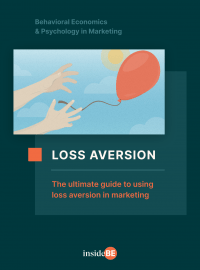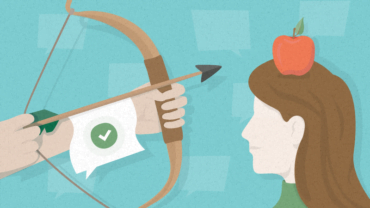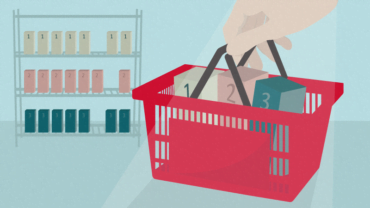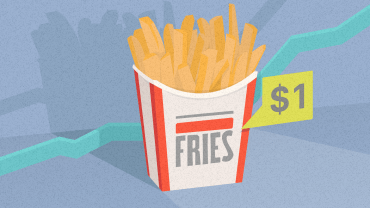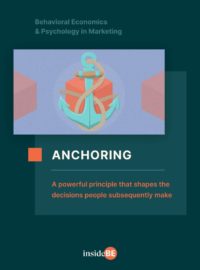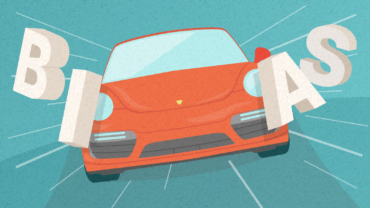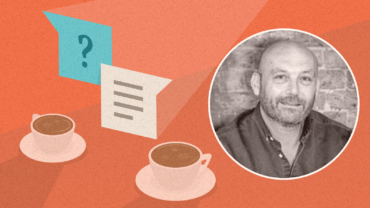Scarcity – Everything You Need to Know

Article content:
Humanity’s obsession with rare things is undeniable. Whether it’s the 17th century Dutch Tulip Mania, the California Gold Rush or today’s million-dollar market for diamonds, we can see countless examples of where rarity has been seen as of incredible value.
But why do people desire rare things so desperately? And can this be used in sales? Keep reading to learn what the scarcity heuristic is, and how to unlock it.

Discover ground-breaking ideas and fascinating solutions.
Definition of Scarcity
The scarcity principle states that the scarcer something is, the more we tend to value it. This is not only an economic principle, but also a powerful behavioral bias, where our brains create an equivalence between the value of an item and its level of rarity or unavailability.
Be it a signed baseball, a handmade gift or a limited-edition watch, people will hold these items near and dear to their hearts, not because of their usefulness, but due to their uniqueness. This makes sense, as even just the difficulty of obtaining or replacing such a product makes it more valuable than something which we can find hundreds of in the store.
The scarcity principle states that the scarcer something is, the more we tend to value it.
Hence, scarcity is a powerful motivational tool and works wonders in a sales setting. Just think about the pictures of people camping in front of the Apple Store to get their hands on the newest iPhone!
No sleep, no food, just the desire to possess something rare.
How does it work?
The scarcity heuristic is the brain assuming that because something is rare or hard to get, it must be good. In turn, if something is widely available, it is seen as less valuable. Just consider this watch:
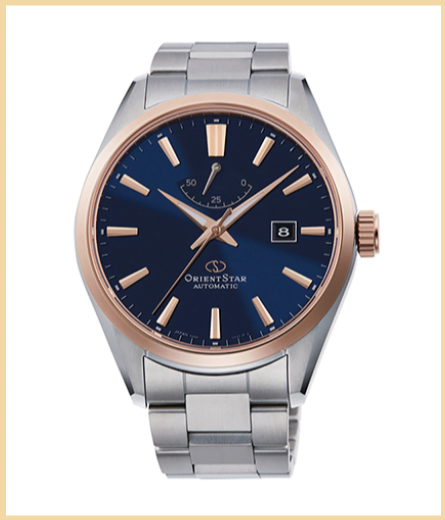
Source: Orient-watch
Pretty, right?
Imagine you’re considering buying it. It has all the features you’ve been looking for and would look great on your wrist. But you’re still hesitant.
Now you learn that it is an exclusive limited-edition release, and there are only a few left in stock! If you don’t buy it, it might be gone by the end of the day!
Suddenly the watch seems like something you must have, right?
Well, when scientists ran this as an experiment with two different product descriptions, they found people were willing to pay an additional 50% for one of them.
Can you guess which one?
Exactly. The limited-edition model was able to fetch a much higher price than its “common” counterpart, despite them both being identical.
This is due to the unique magic of scarcity. Scarce items make us feel emotions, which in turn generate desire for them.
Scarce items somehow just appear more valuable, even if there is no particular reason why they should.
Whether it is the feeling of power or exclusivity, people purchase scarce items seeking to experience these emotions. Similarly, scarce items somehow just appear more valuable, even if there is no particular reason why they should. It is on this premise that VIP areas or airport membership lounges operate, and that items such as the notoriously unattainable Birkin bag by Hermès thrive.
Check out how its limited availability makes the Birkin bag a supposedly even better investment than gold or the stock market.
Source: YouTube
Being drawn to items which are in short supply can be great because it can help us overcome decision inertia. When struggling to reach a decision, the pressure of potentially losing out on an item can be exactly what pushes you over the edge to buy, and thereby saves you from over-contemplating the decision.
However, scarcity can also make us act irrationally. Since we want what we can’t have, people will pay unreasonable sums for rare stuff, even if they can’t really afford it. Scarcity also plays into our ego. If there is an unlimited desire for a limited item, possessing it, and thereby winning in the competition against others, can feel incredibly satisfying. Indeed, narcissistic individuals have been found to have a greater desire to possess scarce items and to buy them with little consideration for their practical use.
Why it works
A probable theory on why we seek rarity is because we simply have a fear of missing out (FOMO) or loss aversion. Scientists found that this fear is already present in 6-year-old children, and functions as a safeguard against competitors. Especially if we are uncertain or do not know the value of something, we will still seek to attain it from competitors because we want to avoid the potential fallout of not having it.
It can also make us feel special and unique, thereby differentiating us from the rest of the pack. Hence, our desire for rare things seems to be an evolutionary survival instinct, which has persisted in our modern life as a behavioral quirk.
This also seems to be supported by neurological evidence, as scarcity affects how rewards are processed in our brains.
Scarcity experiments
Cookies. Cookies. Cookies.
A great demonstration of how we irrationally value rare things was exhibited by three American psychologists in 1975.
Participants in the experiments were presented with two jars containing either two or ten cookies, which were either exchanged or framed by researchers.
When exchanged, a researcher would come in with a cookie jar, and after complaining about their participants (not) eating their cookies, would exchange their cookie jar with the one in front of the participant. Thus, the participant would either go from having 10 cookies to only two, or vice versa.
Additionally, the participant would be informed that:
- there were very few other participants in the study (abundant availability of cookies)
- a large number of participants had yet to be tested (scarce availability of cookies)
Finally, the participant would be asked to taste the cookies and then rate the cookie jar’s attractiveness.
What did they find?
Scarcity makes everything, even cookies, more attractive, and this effect is magnified if availability drops or there is high perceived demand.
First, the cookies in scarce supply were rated as more attractive than the abundantly available cookies.
Second, when the number of cookies dropped from being abundant (10) to scarce (2), they were deemed more valuable than cookies which were consistently scarce (2).
Third, participants rated cookies higher when there were only a few available due to high demand, than when there were few available “accidentally”.
Hence, scarcity makes everything, even cookies, more attractive, and this effect is magnified if availability drops or there is high perceived demand.
Shelf-life scarcity
Just how strong and reliable scarcity is was demonstrated by Stacey Robinson, Michael Brady, Katherine Lemon, and Michael Giebelhausen in 2016. In four studies, they exhibited that when consumers are faced with shelf-based scarcity, their behavior changes significantly as a result.
Over the course of four experiments, they made participants choose between bottles of sunscreen, bars of soap, and even computer chips. The availability of the options (scarce or abundant) was manipulated for the experiments.
What did they find?
Well, scarcity does its job remarkably well!
For one thing, scarcity increases the customer’s willingness to pay, even if the choices are completely identical. In fact, customers choosing between two identical sunscreens were willing to pay 13.29% more for the one which there were fewer available of!
Customers choosing between two identical sunscreens were willing to pay 13.29% more for the one which there were fewer available of!
Even in a real-life shopping scenario, this preference prevailed. In a high-end beauty products store, shoppers were offered a complimentary bar of French soap with their purchase. To get it, they had to choose from two jars with very similar options, one filled with 24 soap bars and the other with 18.
Can you guess what people opted for?
That’s right! Of 56 individuals, 37 people chose the rarer option, and only 19 people opted for the abundant option. As there was no real difference between the two options, the culprit had to be our good friend scarcity.
Scarcity also influenced customers in a second way: by increasing the likelihood of customers selecting an unfamiliar brand.
When asked to choose between two computer chips, of which one was the well-known brand Intel and the other was the rather less familiar brand Turion, participants opted for the Turion chip if it was scarce and the Intel ones were abundant.
This is significant as consumers usually use brand as a proxy for product value to attenuate uncertainty. Yet, the cognitive signalling of unavailability raised the perceived product value to make it the superior choice!
History
The idea that an item that is rare, or is becoming rare, is more valuable, is not a new one. As early as 1932, Lionel Robbins linked scarcity to economic value and highlighted it as a cornerstone of economic markets.
However, it was Robert Cialdini who developed the concept of scarcity as a heuristic, coined in his book Influence. He pointed out that human thinking is susceptible to wanting what is hard to get, hence valuing it in an irrational way. Examples of this can be found all around us, whether in our everyday lives or on a larger scale.
An illustrative example of this is the collectables market, and within that, the phenomenon of what some call the “precious mistake”. Flawed items, such as blurry stamps or double-struck coins have no real worth, yet are highly sought after. Ironically, the imperfections which make them otherwise rubbish, are the basis of their rarity and therefore their value.
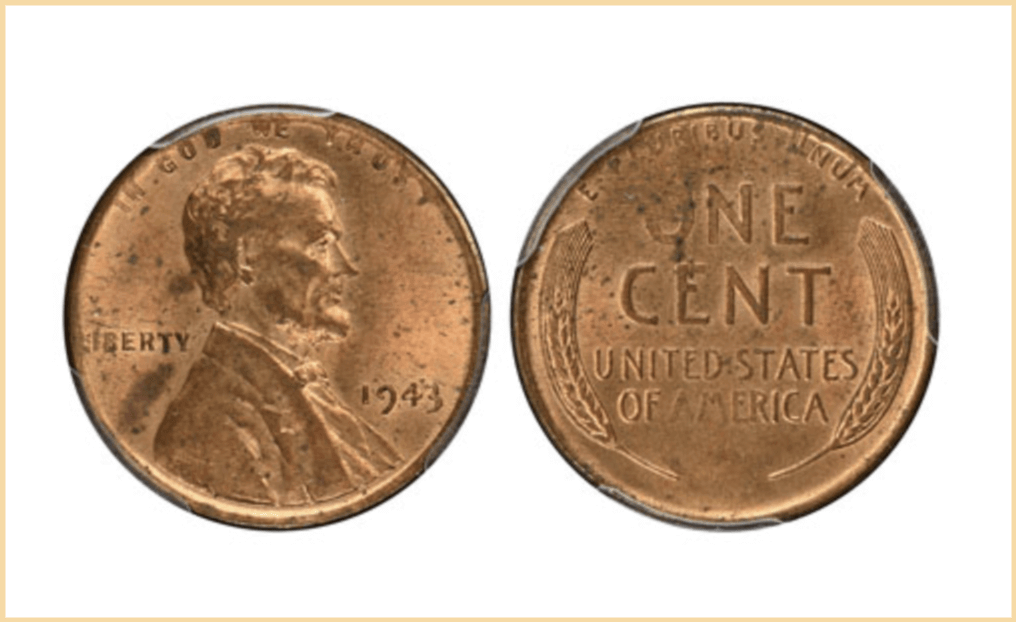
Source: Copper
Loss aversion
Why is scarcity so impactful?
Because it is boosted by one of our most powerful biases: loss aversion.
Identified by the fathers of behavioral economics, Daniel Kahneman and Amos Tversky, loss aversion is often seen as a cornerstone of the discipline.
People experience losses twice as much as gains, and they will go to extreme lengths to avoid experiencing them.
The bias simply states that people experience losses twice as much as gains, and they will go to extreme lengths to avoid experiencing them.
Sound familiar?
Well, it should!
A large part of desiring scarcity is motivated by the fear of missing out.
If something is rare, there is a higher chance of not getting it. This in turn triggers loss aversion (because we don’t want to lose the chance of gaining an item or missing out on its benefits) making people even more motivated to try to attain the item.
Let’s imagine an app you frequently use offers you a one-time chance to get lifetime access to their premium subscription at a big discount.
While you normally wouldn’t become a premium subscriber, the fact that this is a one-time chance makes you really consider the offer! Additionally, it’s a great deal, and declining it now could mean you have to pay much more later on. So, you subscribe.
Boom, scarcity, and loss aversion strike again. The Bonnie and Clyde of BE.
Social proof
Another great bias supporting the scarcity heuristic is social proof. Also the brainchild of Robert Cialdini, this is the human tendency to look at other people’s behavior and be swayed by it, especially in ambiguous circumstances.
In the spirit of “monkey see, monkey do”, social proof can keep us safe by understanding social cues which might indicate danger. For example, in the case of a fire, you might not see the flames or the smoke yet, but if the people around you start exiting the building en masse, you will most likely join in and escape a fatal situation.
However, social proof is also what can keep us in highly damaging situations. It is incredibly hard to break the chains of assimilation, which makes social proof one of the main reasons why cult members stay in toxic cults and accept considerable restrictions on their way of life, relationships and personal choice.
Similarly, social proof can elicit the “bystander effect”. The passivity of the crowd, and the inability to break out of it, is why people can be beaten to death in large crowds, or disasters can take place without any bystanders intervening.
It is partially thanks to this potency that scarcity has such a grip on our minds.
Often a shortage of something indicates high demand for it. Whether it’s berries in the prehistoric woods or rolls of toilet paper in a mid-pandemic Tesco, the fact that a number of people deemed these items worth having increases the pressure on you to get them as well, right now.
This drive for conformity is what makes social proof and scarcity so powerful.
Examples and case studies
56% increase in sales of KFC french fries
An age-old question of marketing is: how to keep the novelty alive?
This question was faced by the Ogilvy Australia team, when tasked with making the KFC $1 fries, which have been running as a seasonal promotion for a couple of years now, seem desirable.
Despite being a great deal, ($1 fries? Hello?? Amazing value for money!) consumer interest was dwindling.
While coming up with the marketing campaign, the Ogilvy team found two genius ways to use scarcity to create customer desire – without changing the product or the price!
First, they nudged customers by saying:
- “$1.00 french fries won’t be around forever.”
No bells and whistles, just a simple reminder of the time constraint on this offer. Result?
FOMO! (and a little bit of loss aversion).
Given the uncertainty around the time period of the offer, people felt inclined to take KFC up on the offer before it was too late. $1 fries are an undeniably good deal, so missing out on them feels like a loss. Plus, rare = more valuable, so those fries instantly seemed even tastier!
For their second tactic, Ogilvy did something counterintuitive: limiting customers in how much they could buy.
Check it out:

Source: Ogilvy Asia
Rather than pushing the quantity disclaimer into the background of their ads, Ogilvy turned it into their main headline.
Why?
Because, thanks to scarcity, arbitrary constraints make people want the items even more! Additionally, the quantity of 4, acts as an anchor for peoples’ perception of how much to purchase. So, instead of maybe getting 2 sets of fries, people will opt for 3 or 4, driving more business for KFC.
You might wonder how the campaign did in real life.
Well, let’s just say, by the end of the promotional period total french fry sales were up by a whopping 56%, making some KFC executives very, very happy.
The charm of the Pumpkin Spice Latte
If you have ever been exposed to American social media, you know that autumn means one thing: never-ending pictures of pumpkin spice lattes!
The iconic beverage is so intertwined with the seasonal change, that it is even used as a euphemism for the fall period.

Source: Parade
Additionally, it’s one of Starbucks’ best-selling products. In 2021 alone, Starbucks’ overall sales rose by 10% during the debut week of the beverage.
But why do seasonal offers such as pumpkin spice latte make people so obsessed, and what role does scarcity play in this?
Well, scarcity is present in the underlying principle of the PSL. Given its limited-time availability over fall, buyers rush to fulfill their pumpkin-spiced cravings while they can, before having to wait another year.
The seasonality also provides loyal customers with excitement and anticipation for the upcoming season. The exclusivity of PSL not only incentivizes purchases, but also increases the average order size.
The exclusivity of PSL not only incentivizes purchases, but also increases the average order size.
While customers buying regular drinks spent an average $6.67 on their order, the average check for PSL buyers was $7.81. This might not seem like an enormous sum, but with an estimated 31.5 million PSLs sold every year, this difference can rake in over $35 million for Starbucks.
Impressive, right?
Incredibly, the money-making magic of the PSL does not stop there! Buyers of the PSL not only spend more on their drink, but also on additional food items during their purchase.
Why does this happen?
Well, purchase cycle analysis showed that buyers viewed these seasonal drinks as indulgent purchases, and in the spirit of treat yo’self, deemed that they might as well get a special treat alongside their drink. This behavior relates to mental accounting, which you can read more about here:
Overall, scarcity can not only boost short-term sales, but also provide the brand with long-term awareness and customer loyalty. Indeed, the majority of PSL buyers were loyal customers, returning yearly for their favorite beverage, forming a crucial core of the Starbucks customer base.
How can you use it in business?
How eBay makes shoppers buy instantly
A tenet of online marketing is that once a customer leaves the purchase funnel, they are unlikely to return of their own accord. As a result, marketers are motivated to coerce customers into a purchase on their first visit, avoiding abandoned sales carts.
As a giant of e-commerce, eBay knows every trick in the book on how to instigate purchases, and draws heavily on scarcity to do so.
Let’s take a look at how:
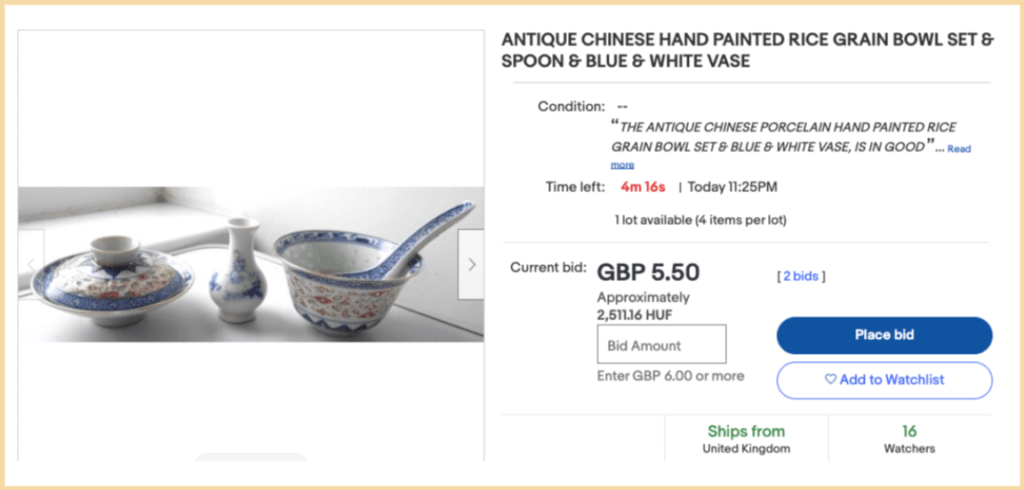
Source: eBay
In this offer of an antique tableware set, scarcity appeals are masterfully at play to coerce you into buying right now.
For instance, there is perceived high demand. Seemingly 16 people are interested in this lovely tableware set, besides the shopper themselves.
Especially in the case of unique items, the knowledge of this existing demand creates a sense of competition among shoppers.
By highlighting other customers’ presence, eBay basically reproduces the two-people-grab-the-same-item-in-the-store trope digitally. Especially in the case of unique items, the knowledge of this existing demand creates a sense of competition among shoppers. Obviously, this further highlights just how rare and in demand this product is, thereby making it even harder to resist.
This competitive pressure is also increased by significantly reducing the time you can think about the offer. Instead of mulling it over for months, you must act in the next 4 minutes to get the set or it is gone forever!
This sense of urgency is intensified by the ticking countdown, tracking literally every second you spend thinking about the offer.
Stressful right?
That’s the way it’s supposed to be. Most people yield to the pressure and the feeling of FOMO, hit the button, and boost the conversion rate of eBay.
But what can eBay do if its product is widely available and far from unique?
Make it seem like it isn’t!
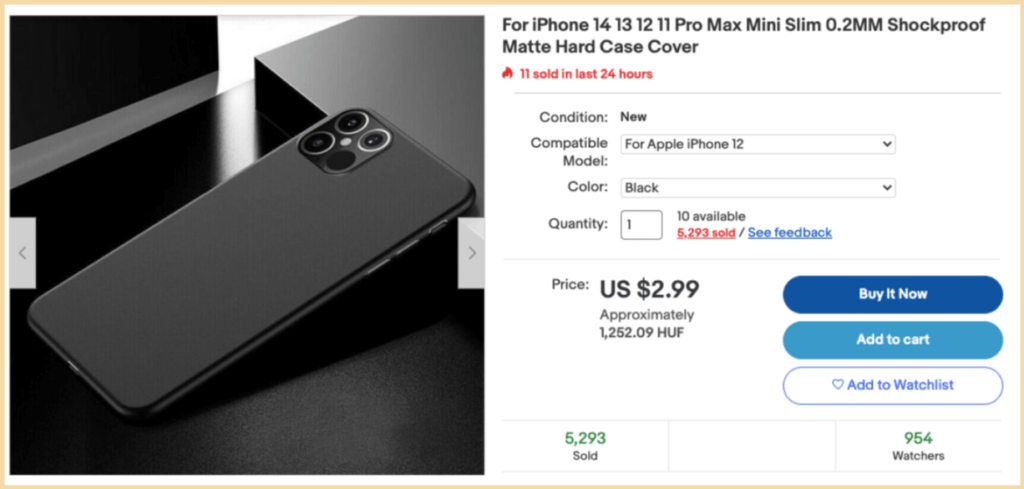
Source: eBay
This phone cover is probably one of the most basic items you can find on the internet. Yet, it seems everybody wants it!
- Do you know why? No!
- Do you care? No!
- Do you want it? Yes!
eBay generates this desire by (again) showcasing seemingly high demand for its product (5000+ sold, 11 recently) with very low stock to match it (only 10 left).
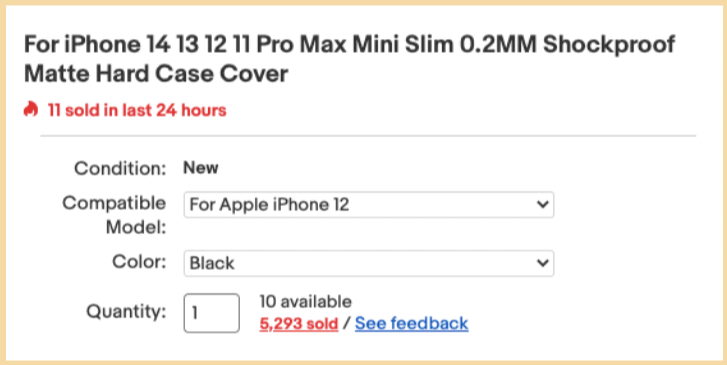
Source: eBay
Low stock notices such as this boost the perceived scarcity of the product, generating desire and pressure to buy today. Additionally, if an item is nearly sold out, it is yet another reason to buy it instantly.
eBay also spotlights the behavior of other customers, by adding how many people are “watching” the product. While these other buyers do not hinder one’s own purchase, the section’s presence cements the illusion of demand and acts as social proof.
Low stock notices such as this boost the perceived scarcity of the product, generating desire and pressure to buy today. Additionally, if an item is nearly sold out, it is yet another reason to buy it instantly.
Overall, for e-commerce, the holy trinity which you need to remember for scarcity appeals is: limited time, high demand, and low stock.
Nintendo and their unattainable Wii console
If you weren’t a gamer back in 2006, you probably don’t remember the mass hysteria around the release of the Wii gaming console.
Released in November 2006, the launch of the console attracted queues stretching for blocks, with some people queuing a week before the release date. Retailers sold out of the game console on launch day, and also struggled to keep their shelves stocked in the months that followed.
The hype around the product was so strong that even after Nintendo upped its monthly production to 1.8 million units, demand continued to outpace supply.
Accusations arose that the short supply was a deliberate strategy by Nintendo.
While there was no official confirmation of this, the low supply of Wii consoles certainly paid off for Nintendo. The firm became the market leader in the following year, outperforming competitors Sony and Microsoft.
Why did this possible blunder work so well?
Remember, scarcity creates desire, and the Wii console was practically unattainable for months! People were desperate to possess it.
Resale prices for the Wii surged to double and triple amounts, and even official retailers jacked up the price of the console. A Nintendo executive even joked that shoppers should “stalk the UPS driver” to identify restocked stores to get a Wii.
Finally, after 48 million units had already been sold, supply caught up with demand.
But what about impatient shoppers who became disgruntled in the meantime?
Well, Nintendo found a genius way to appease them, without actually changing anything!
Membership in the program offered differentiation from other buyers and carried a sense of control over the uncertain purchase.
The firm launched a “rain check” program, where customers prepaid the console price with the promise of receiving one by the end of the following year.
While this offered only a vague guarantee, customers felt recognized for their struggle. Additionally, the program played on an important emotion of scarcity: exclusivity.
Membership in the program offered differentiation from other buyers and carried a sense of control over the uncertain purchase.
Spotify and its invite-only membership
When Spotify started their sprawl around the world, the company relied on a single thing to gain notoriety and popularity: exclusivity.
When looking to sign up to Spotify in 2011, US users were confronted with a problem. Instead of being able to simply create an account, users needed to join a waitlist for Spotify-issued invitations or hunt down an invitation from benevolent-feeling, existing users.
Those looked similar to this:
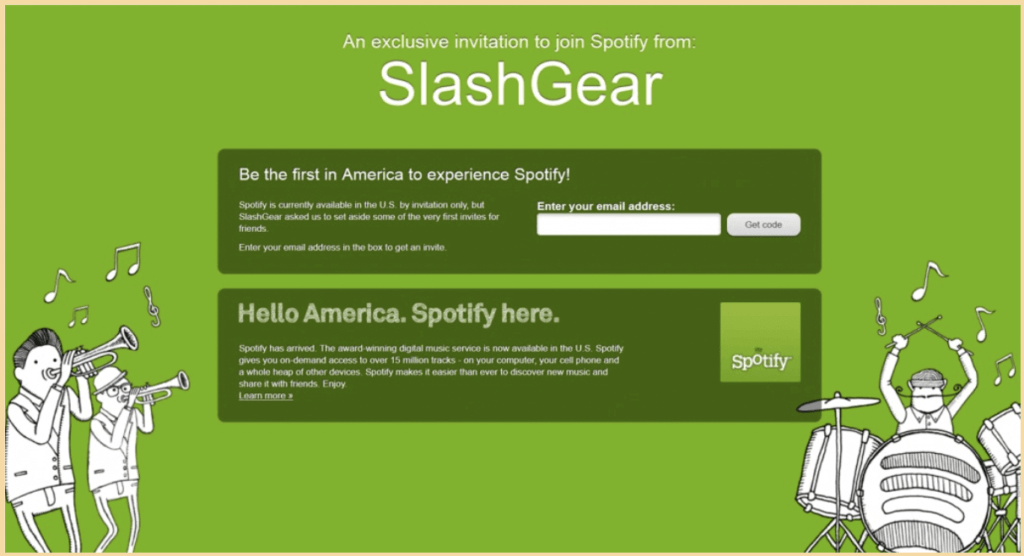
Source: AndroidNet
This barrier to entry served two main purposes:
- For one, it allowed Spotify to gauge their relative popularity in the US and avoid the pitfall of a disappointing launch event.
- Second, it attracted attention and kept Spotify’s elusive charm alive.
In the spirit of a high-school cafeteria, Spotify formed its very own “exclusive” lunch table, where only the select, cool kids could sit.
And what do people love?
To have what others can’t have.
Such scarcity-based appeals were also found to raise the perceived value of items, making the Spotify service seem even better.
Hence, people were practically queuing to join the music-streaming platform’s “table”. Such scarcity-based appeals were also found to raise the perceived value of items, making the Spotify service seem even better.
Spotify also offered options for customers who could not find or could not be bothered with getting invitations: premium accounts. While invitations were required to get a free Spotify account, signing up for a £10-per-month premium account was instantaneous.
Given that in 2022 Spotify is the biggest music streaming platform in the world, the strategy seems to have paid off. Indeed, even following its success Spotify has remained true to its roots (and scarcity).
Check out what users in the Middle East saw when looking to join the launch of Spotify in the region:
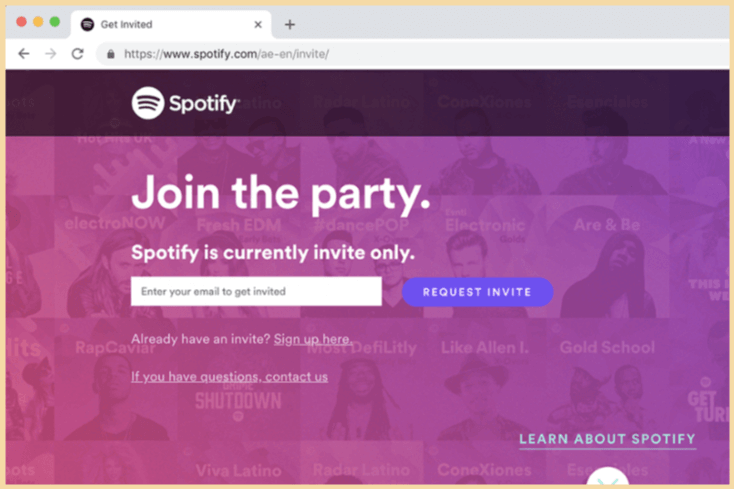
Source: Expatwoman
Beware of the drawbacks!
If you have read this article this far, you know by now that scarcity is a powerful tool and can be a great economic asset. However, as the saying goes, with great power comes great responsibility.
Limited-time discounts such as Black Friday or Cyber Monday can attract an incredible amount of business. Online sales alone accounted for $8.9 billion in 2021!
Reckless usage of scarcity can lead to actual violence and even death. People have shown unprecedented levels of aggression, and a number of violent incidents are reported every year among shoppers.
At the same time, reckless usage of scarcity can lead to actual violence and even death. Particularly during shopping-crazed holidays, people have shown unprecedented levels of aggression, and a number of violent incidents are reported every year among shoppers. Incidents range from verbal and physical assault to the robbery and even shooting of fellow shoppers. Websites have even popped up dedicated to keeping track of the victims of Black Friday.
The question arises, why do scenes such as these occur?
The answer is, unfortunately, scarcity.
Studies have found that the mere exposure of consumers to ads with a scarcity appeal leads to increased testosterone in participants. The exposed consumers also behave more violently than non-exposed consumers, whether it is punching a vending machine more violently or shooting more rounds into a target.
As this response occurred in response to just a digital ad, the real life rise in aggression must be incomparably more intense, leading to the intimidating images of Black Friday brawls.
So how can scarcity be used safely?
Well, apparently aggressive responses to scarcity occur in response to limited quantity, but not limited time. This is because under quantity restraints, obtaining the item first is imperative to actually getting it, hence anybody in the way of that is a threat. At the same time, under time pressure, the “obstacle” is not another person, but the time limit itself. Here, as long as we acquire the item in the time frame, we will be able to own it.
So, including time-based offers, rather than quantity-based offers could help reduce consumer aggression, particularly in high-pressure shopping situations such as Black Friday.
Including time-based offers, rather than quantity-based offers could help reduce consumer aggression, particularly in high-pressure shopping situations such as Black Friday.
Additionally, the heightened level of anger and aggression from these competitive situations also translates into non-aggressive consequences. Customers who failed to obtain a limited edition item were reported to have heightened intentions of switching to a competitor, due to the brand eliciting their disappointment.
Consequently, scarcity as a sale tactic should only be used in moderation. To avoid unwanted customer behavior, campaigns centered on exclusivity should rely on time-based, not quantity-based scarcity. Additionally, sales staff or the online catalog should offer suitable alternatives for disappointed customers, so as to avoid losing consumers.
Summary
What is the scarcity bias?
Scarcity is the bias of assuming something is more valuable if it is rare, than if it’s widely available. The heuristic also leads people to consider something rare to be of better quality, regardless of the reality of that assumption.
Why does it work?
Our preference for scarce things exists due to the heuristic’s evolutionary role. In the past, it was more beneficial to attain something that was in low supply, rather than risk losing out on it. This ensured personal wellbeing and mitigated the risk of decision uncertainties. The ownership of rarities also provided social standing and differentiation from others. Additionally, scarcity generates emotions such as a sense of power and exclusivity, which motivate people into action in a quest to experience them.
How can you use it in business?
Scarcity is a powerful motivator for customers and can generate high conversion rates if employed correctly. In general, the holy trinity of scarcity appeals are: demonstrate a limited sale time, illustrate high demand, and notify of low stock. Tactically-employed limited-time offers can generate both short-term sales, and long-term revenue from customer loyalty and branding. Arbitrary constraints to customer consumption can also heighten perceived value and desirability.
However, scarcity appeals need to be employed cautiously, as supply-based scarcity increases the likelihood of aggressive behavior. Additionally, continued disappointment and impatience can lead customers to abandon the brand, and switch to competitors. Hence, suitable alternatives to limited products should be offered. Overall, time-based offers seem to circumvent issues of customer aggression and brand-oriented frustration.

